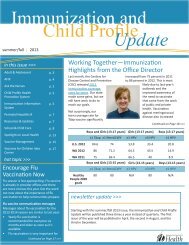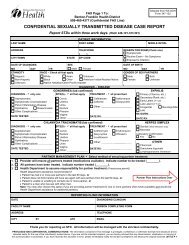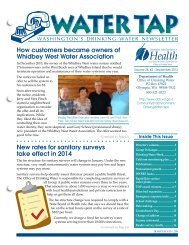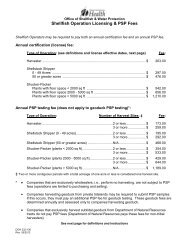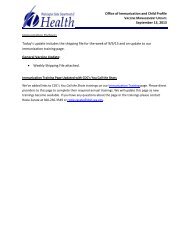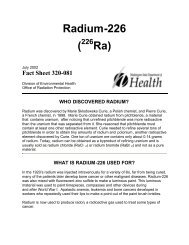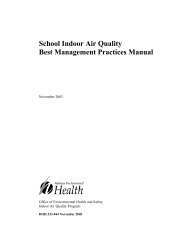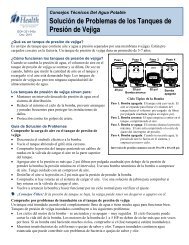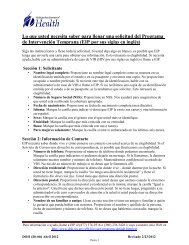Salmonellosis Reporting and Investigation Guideline - Washington ...
Salmonellosis Reporting and Investigation Guideline - Washington ...
Salmonellosis Reporting and Investigation Guideline - Washington ...
You also want an ePaper? Increase the reach of your titles
YUMPU automatically turns print PDFs into web optimized ePapers that Google loves.
<strong>Salmonellosis</strong><br />
<strong>Reporting</strong> <strong>and</strong> Surveillance <strong>Guideline</strong>s<br />
4. Persons should not work as food h<strong>and</strong>lers, child care or health care workers, or attend<br />
child care as long as they have diarrhea. (see Section 6 - Managing Special Situations)<br />
5. Stool cultures to document that fecal shedding of the organism has stopped are not<br />
routinely indicated, except for the purpose of lifting work restrictions (see below).<br />
Food h<strong>and</strong>lers serving highly susceptible populations:<br />
Food workers in facilities serving highly susceptible populations (e.g. hospitals, child<br />
care center or nursing homes) should not return to work until two consecutive negative<br />
stool cultures for Salmonella are collected not less than 24 hours apart, <strong>and</strong> at least 48<br />
hours after the last dose of antibiotics.<br />
Food h<strong>and</strong>lers in establishments serving the general population:<br />
Food h<strong>and</strong>lers must not return to work until asymptomatic. The local public health<br />
authority may issue work restriction (or exclusion) orders <strong>and</strong> release individuals from<br />
restriction based on individual case investigation. For asymptomatic infected individuals,<br />
restriction is indicated for those with questionable hygienic habits, or where Salmonella<br />
transmission is suspected to have occurred in the workplace. Release by the local health<br />
authority from work restriction may be based either on 2 consecutive negative stool<br />
specimens taken at least 24 hours apart, or on assessment of the ability of the individual<br />
to maintain adequate hygienic precautions.<br />
Health Care workers:<br />
Nosocomial outbreaks due to asymptomatic infected healthcare workers are uncommon.<br />
Release by the local health authority from work restriction may be based either on 2<br />
consecutive negative stool specimens taken at least 24 hours apart, or on assessment of<br />
the ability of the individual to maintain adequate hygienic precautions. Health care<br />
workers who prepare food should be managed as food h<strong>and</strong>lers.<br />
Child Care workers <strong>and</strong> attendees<br />
Nontyphoidal Salmonella species are infrequently associated with outbreaks in child care<br />
settings. Child care workers <strong>and</strong> child care attendees can return to work when their<br />
diarrhea has resolved <strong>and</strong> they are otherwise feeling well. (Red Book 2009 pp.130-1,<br />
584–8). Child care workers who prepare food should be managed as food h<strong>and</strong>lers.<br />
Salmonella Paratyphi Infections<br />
It is recommended that persons infected with S. Paratyphi who present with paratyphoid<br />
fever be excluded from sensitive occupations until 2 consecutive negative stool cultures<br />
taken at least 24 hours apart are obtained.<br />
B. Identify Potential Sources of Infection<br />
Take a food history. Note br<strong>and</strong> <strong>and</strong> purchase or source information for high risk foods.<br />
Ask about potential exposures during at least the 5 days before onset (1–10 days or<br />
longer for paratyphoid fever), including:<br />
1. Any contacts or household members with a similar illness. Obtain the name, phone<br />
number or address <strong>and</strong> clinical information of the ill person.<br />
2. Restaurant meals. Obtain the name of the restaurant, <strong>and</strong> date <strong>and</strong> location of the meal.<br />
Last Revised: January 2013<br />
Page 5 of 8<br />
<strong>Washington</strong> State Department of Health



